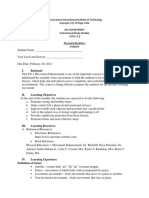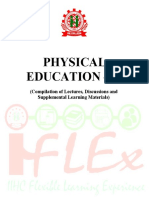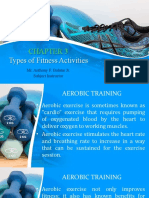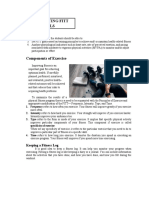Shs 11 Pe Health M 2
Shs 11 Pe Health M 2
Uploaded by
Chloe AlceraCopyright:
Available Formats
Shs 11 Pe Health M 2
Shs 11 Pe Health M 2
Uploaded by
Chloe AlceraOriginal Title
Copyright
Available Formats
Share this document
Did you find this document useful?
Is this content inappropriate?
Copyright:
Available Formats
Shs 11 Pe Health M 2
Shs 11 Pe Health M 2
Uploaded by
Chloe AlceraCopyright:
Available Formats
Republic of the Philippines
UNIVERSITY OF EASTERN PHILIPPINES
University Town, Northern Samar, Philippines
Web: http://uep.edu.ph; Email: uepnsofficial@gmail.com
UEP SENIOR HIGH LABORATORY
SCHOOL
AEROBIC & ANAEROBIC
ACTIVITIES
NAME: ________________________________________________
STRAND & SECTION: ______________________
JOHN EDUARD C. ABANES, LPT
Subject Teacher
Physical Education & Health Module 2: AEROBIC & ANAEROBIC ACTIVITIES
OVERVIEW OF THE OF THE MODULE
This module discusses the importance of Aerobic activities as
part of living a healthy lifestyle.
Purpose of the Module
This module aims to develop students’ ability to understand that
this subject area be properly defined and interpreted so that it will receive
its rightful emphasis in the educational program.
Module Title
AEROBIC ACTIVITIES
Module Guide
In going about this module, here is a simple guide for you:
1. Read and follow the instructions carefully.
2. Read each lesson and do all the activities that are provided for you.
3. Perform all the activities diligently to help and guide you in
understanding the topic.
4. Answer the assessment to measure how much you have gained
from the lessons.
Module Outcomes
After going through this module, you are expected to:
1. Discuss Aerobic and Anaerobic activities
2. Value the fact of engaging oneself to aerobic activities
3. Perform aerobic and anaerobic activities
Physical Education & Health Module 2: AEROBIC & ANAEROBIC ACTIVITIES
LEARNING PLAN
AEROBIC EXERCISE
Aerobic exercise is a physical activity that uses large muscle groups
in your body. This type of exercise is usually rhythmic and repetitive. You
can adjust the intensity of your workout, which is how hard your body
works during this type of exercise.
Aerobic exercises increase your heart rate and how much
oxygen your body uses. The term aerobic means “with oxygen.”
When you practice aerobic exercise, your breathing controls the
amount of oxygen that reaches your muscles to help you burn
energy and move.
WHAT IS THE DIFFERENCE BETWEEN AEROBIC AND ANAEROBIC
EXERCISES?
Aerobic and anaerobic are terms that define how your body
produces energy.
Aerobic means “with oxygen.” When you participate in a
continuous activity that increases your heart rate, your cells use
oxygen to produce energy. An example of aerobic exercise is
walking.
Anaerobic means “without oxygen.” When you engage in a
quick, high-intensity activity, your cells aren’t using oxygen to
produce energy. An example of an anaerobic exercise is lifting
weights.
Whether the energy we need during exercise comes from aerobic or
anaerobic processes depends on the intensity, duration and types of
muscle fibers used. When we do anaerobic exercises, our body works
intensely over a short period of time and therefore needs energy fast. This
energy comes from components that are already stored in our body and
are readily available. This process doesn’t require oxygen, but the amount
of energy that can be released this way is quite limited.
The aerobic system is slower than the anaerobic system since
oxygen must reach the muscles through our circulation prior to the
release of energy. During aerobic exercises, which are less intense
but last longer, our lungs and heart work hard to supply oxygen to
the body. The body uses this oxygen to break down energy sources
like fats and glucose to release energy we can use to perform the
exercise. In general, aerobic processes use the oxygen to produce
more energy than anaerobic processes, but anaerobic processes
release energy faster.
Physical Education & Health Module 2: AEROBIC & ANAEROBIC ACTIVITIES
It can be good to think of aerobic and anaerobic exercises on
a scale from ‘mostly aerobic’ to ‘mostly anaerobic’, instead of a
clear line between the two. Also, many sports involve a mix of both
types, for example mostly aerobic walking and jogging with short
bursts of mostly anaerobic sprinting. The exact energy contribution
to the total energy demand is also individual and can be influenced
by factors such as amount of regular training and our diet.
Figure 1: During exercise, our body releases energy via aerobic or
anaerobic processes. The intensity and duration of the activity determine
which process supplies the most energy. The exact energy contribution is
however individual and can be influenced by factors such as amount of
training and diet composition.
AEROBIC = ENDURANCE ANAEROBIC = STRNGTH
& POWER
AEROBIC (ENDURANCE) EXERCISE
In what is usually categorized as an aerobic exercise, aerobic
processes dominate in the release of energy that the body can use
to perform. Aerobic exercise is often referred to as endurance or
cardio exercise and happens when the large muscles in the body
move in a rhythmic manner for a long period of time.1 Aerobic
Physical Education & Health Module 2: AEROBIC & ANAEROBIC ACTIVITIES
exercise involves increasing oxygen consumption by the body. Our
body does this by increasing the breathing and heart rate. This kind
of exercise is important for many body functions and helps keep our
heart, lungs and circulatory system healthy, as well as improving
our cardiorespiratory fitness.
(Walking, running, cycling and swimming are examples of aerobic
exercise.)
ANAEROBIC (STRNGTH & POWER) EXERCISE
In what is often categorized as anaerobic exercise, anaerobic
processes dominate in releasing energy that the body can use to perform.
Anaerobic exercise, such as strength and power training, will enhance our
muscle power, strength and size. This includes performing exercises at
high intensity over a short duration, usually on a scale of seconds to a few
minutes.
(Sprinting, lifting weights (free weights or resistant machines),
resistance band exercises, and bodyweight exercises (e.g. push-
ups, pull-ups, squats, lunges) are examples of anaerobic
exercise.)
Physical Education & Health Module 2: AEROBIC & ANAEROBIC ACTIVITIES
LEARNING TASK
Instruction: Analyze each exercise inside the rectangle, and
identify whether it is Aerobic exercise or Anaerobic exercise. Write it
on the space provided below.
Squats Running Swimming Pull-ups
Walking Push-ups Lunges Cycling
Sprinting Weight lifting
AEROBIC EXERCISES ANAEROBIC EXCERCISES
• •
LEARNING PLAN
BENEFITS OF ANAEROBIC ACTIVITIES
The benefits of anaerobic exercise include:
Increases bone mass density
Slowing the natural loss of bone
Reduce the risk of osteoporosis
Maintains muscle mass and boost development
Improves muscle strength
Burn Fats
BENEFITS OF AEROBIC ACTIVITIES
The benefits of aerobic exercise include:
Building stronger bones.
Physical Education & Health Module 2: AEROBIC & ANAEROBIC ACTIVITIES
Improving your muscle strength, endurance and flexibility.
Improving your balance.
Increasing your mental function.
Assisting in weight management and/or weight loss.
In addition, aerobic exercise can:
Reduce your risk of developing heart disease, hypertension, stroke
or diabetes.
Improve your lung function.
Lower your blood pressure.
Increase HDL or "good" cholesterol.
Help to better manage your blood sugar.
WHAT ARE THE RISKS OF AEROBIC EXERCISES?
Participating in physical activities can put you at risk of injury, including:
Sprains and strains
Bone fracture
Joint pain
Muscle cramps
Pain or soreness
HOW OFTEN SHOULD I DO AEROBIC EXERCISES?
You should get about 150 minutes of physical activity each
week. The amount per week equals about 30 minutes a day, five
days a week. This is the recommended minimum guideline for
reducing your risk of heart disease, diabetes, hypertension and high
cholesterol.
It can be overwhelming to accomplish 150 minutes of aerobic activity
each week. To make this amount of time easier to accomplish, follow
these tips:
Schedule time during your day for physical activity.
Choose activities that you enjoy doing.
Exercise in small increments of time, for example, take three
shorter walks that are 10 minutes each in a day.
Participate in activities with your friends or family.
Physical Education & Health Module 2: AEROBIC & ANAEROBIC ACTIVITIES
You can do aerobic exercises every day. There’s no need to rest in
between sessions unless you’re at an extreme level of training, such
as preparing for a marathon, or if you experience reoccurring joint pain. If
joint pain is a limiting factor, talk to your healthcare provider about less
painful exercises.
HOW DO I DO AEROBIC EXERCISES?
An aerobic exercise should happen in three steps:
A warmup period.
Progression of the exercise.
A cooldown period.
LEARNING TASK
Instruction: Kindly give completely what are being asked.
1. What are the risks or aerobic exercises?
2. Give at least five (5) benefits of anaerobic exercises.
3. Give at least five (5) benefits of aerobic exercises.
4. Give at least five (5) examples of aerobic exercises.
5. Give at least five (5) examples of anaerobic exercises.
Physical Education & Health Module 2: AEROBIC & ANAEROBIC ACTIVITIES
PERFORMANCE TASK
Instruction: Perform five (5) Aerobic Activities and five (5)
Anaerobic Activities. Take pictures and paste here.
Physical Education & Health Module 2: AEROBIC & ANAEROBIC ACTIVITIES
ASSESSMENT TASK
Why it is important to engage ourselves in different Aerobic and
Anaerobic Activities? (20 points)
Physical Education & Health Module 2: AEROBIC & ANAEROBIC ACTIVITIES
REFERENCES
https://my.clevelandclinic.org/health/articles/7050-aerobic-exercise
https://www.eufic.org/en/healthy-living/article/the-difference-
between-aerobic-and-anaerobic-exercise#:~:text=Both%20aerobic
%20and%20anaerobic%20exercise,mainly%20increase%20our
%20muscle%20strength.&text=The%20World%20Health
%20Organization%20recommends,the%20period%20of%20a
%20week.
Physical Education & Health Module 1: Good Life
You might also like
- AvalancheDocument152 pagesAvalanchealiam555100% (6)
- Affa Textbook 9781284402803 FULL InteractivDocument368 pagesAffa Textbook 9781284402803 FULL InteractivPia Alesci100% (3)
- 12 Week Jim Stoppani WorkoutsDocument3 pages12 Week Jim Stoppani WorkoutsLinda LyerlyNo ratings yet
- Catalyst At-Home Training Plan Reference Document 1.1 PDFDocument18 pagesCatalyst At-Home Training Plan Reference Document 1.1 PDFmarcos jimenezNo ratings yet
- HOPE 1 MODULE 2 Principles of Training 101 1Document9 pagesHOPE 1 MODULE 2 Principles of Training 101 1Leo Patrick100% (1)
- Https:Pepdigital.s3.Us East 2.amazonaws - com:Speed+and+Agility+Accelerator:SAP+Phase+1Document37 pagesHttps:Pepdigital.s3.Us East 2.amazonaws - com:Speed+and+Agility+Accelerator:SAP+Phase+1yohan mironNo ratings yet
- PATHFIT 1 Module 1Document61 pagesPATHFIT 1 Module 1bjenggNo ratings yet
- Tengen Uzui Calisthenics Workout PDFDocument9 pagesTengen Uzui Calisthenics Workout PDFKrrish AdhanaNo ratings yet
- PE 1 - Lesson 4Document8 pagesPE 1 - Lesson 4Joel B. EstepaNo ratings yet
- Types of ExerciseDocument2 pagesTypes of ExerciseAdrian BagayanNo ratings yet
- 5 Anaerobic + Aerobic ExerciseDocument9 pages5 Anaerobic + Aerobic Exercisekhush sidhuNo ratings yet
- Week 012-Aerobic ExercisesDocument4 pagesWeek 012-Aerobic ExercisesDhea Angela A. CapuyanNo ratings yet
- Lesson 1 - P.EDocument37 pagesLesson 1 - P.ERoselyn SantaNo ratings yet
- Almeria Pe 1 Finals Module Leganes Bsa 1 D e FDocument20 pagesAlmeria Pe 1 Finals Module Leganes Bsa 1 D e Fma. tricia soberanoNo ratings yet
- PED 031 SAS Module 2Document7 pagesPED 031 SAS Module 2marygraceespanyolNo ratings yet
- Fitness PPT 1Document11 pagesFitness PPT 1kaungthit51188No ratings yet
- Physical Activity and ExerciseDocument23 pagesPhysical Activity and ExerciseJoniemar RosalejosNo ratings yet
- P.E 1 Module 4Document11 pagesP.E 1 Module 4Cherry lyn EnadNo ratings yet
- Module 1 Physical EducationDocument3 pagesModule 1 Physical EducationMichelle Anne Rubio BungalonNo ratings yet
- August 2Document21 pagesAugust 2Lorry DoronNo ratings yet
- Physical ActivityDocument29 pagesPhysical ActivityIvan Exekiel CabrillasNo ratings yet
- PE and Health ModuleDocument46 pagesPE and Health ModulePinky Moral100% (1)
- Aerobic FilesDocument2 pagesAerobic FilesEdna RazNo ratings yet
- Physical Fitness Unit OneDocument26 pagesPhysical Fitness Unit Onebesedegefub9131No ratings yet
- Physical Education Grade 11 Module First Sem Lessons 1 9Document51 pagesPhysical Education Grade 11 Module First Sem Lessons 1 9sadeiacizdmrNo ratings yet
- Archie PeDocument20 pagesArchie Pejbl.libra009No ratings yet
- HOPE1REVIEWERDocument12 pagesHOPE1REVIEWERWilson CadienteNo ratings yet
- PE 11 Q1 Module 1 Week 1Document11 pagesPE 11 Q1 Module 1 Week 1Ailyn RoncalesNo ratings yet
- Pe and Health 11 Modules Week 1 and 2Document12 pagesPe and Health 11 Modules Week 1 and 2RODJHEN ANNE P. BARQUILLANo ratings yet
- PHYSICAL EDUCATION 11 Lesson 1Document41 pagesPHYSICAL EDUCATION 11 Lesson 1Arthur LaurelNo ratings yet
- Learning Material in Hope 1Document5 pagesLearning Material in Hope 1Adrian AribatoNo ratings yet
- Pe11 Week1Document1 pagePe11 Week1justhine pilapilNo ratings yet
- Components of Training - IDocument17 pagesComponents of Training - IYouTube MirchiNo ratings yet
- Aerobics and Anaerobic ExerciseDocument19 pagesAerobics and Anaerobic ExerciseKirin Ira VicenteNo ratings yet
- Aerobic AnaerobicDocument16 pagesAerobic AnaerobicHamil BanagNo ratings yet
- Health g11 WK 1 Module 1Document9 pagesHealth g11 WK 1 Module 1Angel BoquecosaNo ratings yet
- Aerobic ExerciseDocument3 pagesAerobic ExercisemeryjuvelhNo ratings yet
- Peh 11 Worksheet 1Document2 pagesPeh 11 Worksheet 1Neo RealyouNo ratings yet
- Pathfit 2 LessonsDocument11 pagesPathfit 2 Lessonsalshameer0130No ratings yet
- Physical Fitness Honour 270112Document28 pagesPhysical Fitness Honour 270112Langton NyatsanzaNo ratings yet
- Pe 1 MidtermDocument8 pagesPe 1 MidtermMia MagbanuaNo ratings yet
- Unit 1 Concepts of Physical FitnessDocument116 pagesUnit 1 Concepts of Physical FitnessnanaNo ratings yet
- Grade 11 Physical Education ModuleDocument19 pagesGrade 11 Physical Education ModuleCherrylyn DonayreNo ratings yet
- Aerobic and Anaerobic Excercises SummaryDocument7 pagesAerobic and Anaerobic Excercises SummaryThermus AquaticusNo ratings yet
- Quarter2 Lesson 1 AEROBICSDocument6 pagesQuarter2 Lesson 1 AEROBICSRowan Yñigo TamayoNo ratings yet
- Physical Fitness Note @NoteHeroBot (Chapters 1-5) - 055005Document174 pagesPhysical Fitness Note @NoteHeroBot (Chapters 1-5) - 055005millionmekuria44No ratings yet
- Physical Fitness and SwimmingDocument65 pagesPhysical Fitness and SwimmingnathanielNo ratings yet
- Group 1 Erudite Pe and HealthDocument31 pagesGroup 1 Erudite Pe and HealthSebNo ratings yet
- How To Start Your Fitness Program: ExerciseDocument7 pagesHow To Start Your Fitness Program: ExerciseChris Angelo TorillosNo ratings yet
- Pe1 - Week 6.1Document25 pagesPe1 - Week 6.1Norman NarbonitaNo ratings yet
- ExerciseDocument6 pagesExerciseJoey Bojo Tromes BolinasNo ratings yet
- Aerobic ActivitiesDocument2 pagesAerobic ActivitiesLorenz Ruiz RomeroNo ratings yet
- Week 1 and 2 P.E and Health 2Document23 pagesWeek 1 and 2 P.E and Health 2Rodelyn Ramos GonzalesNo ratings yet
- Aerobic Exercise For Health and FitnessDocument3 pagesAerobic Exercise For Health and FitnessAngel MejiaNo ratings yet
- PHED 11 Chapter 3 - PE and HealthDocument45 pagesPHED 11 Chapter 3 - PE and HealthAnthony Feraer Balatar Jr.No ratings yet
- Aerobic Adaptation and Factors Affecting The Aerobic Training ResponseDocument2 pagesAerobic Adaptation and Factors Affecting The Aerobic Training ResponsekenjiyanasanNo ratings yet
- History of AirobicsDocument17 pagesHistory of AirobicsShivi Vaibhav SharmaNo ratings yet
- Module 1 SoftDocument10 pagesModule 1 SoftJason SebastianNo ratings yet
- Health 2 ExamDocument26 pagesHealth 2 ExamRussell Von DomingoNo ratings yet
- Aerobic Vs Anaerobic: DanceDocument5 pagesAerobic Vs Anaerobic: DanceMicah VitorNo ratings yet
- The Exercise ProgramDocument44 pagesThe Exercise Programangeloumali42No ratings yet
- Reviewer in Pe and HealthDocument16 pagesReviewer in Pe and HealthJean DaclesNo ratings yet
- Physical Education and Health ReviewerDocument4 pagesPhysical Education and Health ReviewerJay-mee Claire V. DioNo ratings yet
- Philippine-Physical FitnessDocument14 pagesPhilippine-Physical FitnessHoney Jean GolezNo ratings yet
- Aerobics Module 1Document16 pagesAerobics Module 1Benilyn PummarNo ratings yet
- Pe 3: Swimming Name: Anjhielyn Mamuad Course and Year: Bsn2-B I. Pre-AssessmentDocument1 pagePe 3: Swimming Name: Anjhielyn Mamuad Course and Year: Bsn2-B I. Pre-AssessmentHanwell Keith SantosNo ratings yet
- Urbanix Catalog Blade and Core 2018Document28 pagesUrbanix Catalog Blade and Core 2018Israfil YıldırımNo ratings yet
- Coronado, Joyce Anne C. - Module 6 - ActivitiesDocument5 pagesCoronado, Joyce Anne C. - Module 6 - ActivitiesHanah Grace GomezNo ratings yet
- Week 3Document15 pagesWeek 3Ivon Quirante CabalesNo ratings yet
- Module Two Wellness PlanDocument14 pagesModule Two Wellness PlanSAMIYAH JAMESNo ratings yet
- Setting Fitt Goals: Components of ExerciseDocument5 pagesSetting Fitt Goals: Components of ExerciseEmily DinamlingNo ratings yet
- Ipt Online Training Informed Consent FormDocument1 pageIpt Online Training Informed Consent FormKevin NewtonNo ratings yet
- Strength and Mobility ExercisesDocument2 pagesStrength and Mobility ExercisesleilagreeyyyNo ratings yet
- Health Related FitnessDocument3 pagesHealth Related FitnessVictor Silva PanojoNo ratings yet
- Maxine Ong - Essay 1Document2 pagesMaxine Ong - Essay 1Maxine OngNo ratings yet
- Raj Orange and Grey Modern Minimal Sport Athletic Trainer ResumeDocument1 pageRaj Orange and Grey Modern Minimal Sport Athletic Trainer Resumevakodaj557No ratings yet
- Daily 28 Days No Gym Total BodyDocument9 pagesDaily 28 Days No Gym Total Bodykago khachanaNo ratings yet
- Upper Body Strength Training ExercisesDocument7 pagesUpper Body Strength Training ExercisespssrijitNo ratings yet
- Fit LifeDocument124 pagesFit LifekalleNo ratings yet
- LESSON PLAN For Demo For Grade 9 Active Receation Fitness and RecreationDocument2 pagesLESSON PLAN For Demo For Grade 9 Active Receation Fitness and RecreationJaishenne CastuloNo ratings yet
- Lesson 2 Book 8Document2 pagesLesson 2 Book 8Sebastian BaldiviesoNo ratings yet
- Semi Detailed Lesson Plan in PEDocument3 pagesSemi Detailed Lesson Plan in PErichard jr layaguinNo ratings yet
- Module 2.1 ParagraphsDocument3 pagesModule 2.1 Paragraphsawyne nozulNo ratings yet
- Recreation, Physical Fitness Activity 2 Done - WADocument2 pagesRecreation, Physical Fitness Activity 2 Done - WAShane GerolagaNo ratings yet
- QUARTER I: Physical Activity and Physical Fitness AssessmentsDocument10 pagesQUARTER I: Physical Activity and Physical Fitness AssessmentsAngie Diño AmuraoNo ratings yet
- 12 Personal TrainingDocument7 pages12 Personal TrainingRizzenellie GonzalesNo ratings yet
- 15 - Balance & Core ExercisesDocument32 pages15 - Balance & Core Exercisesbreinfout fotosNo ratings yet
- Cambridge International General Certificate of Secondary EducationDocument16 pagesCambridge International General Certificate of Secondary EducationDisha's Language SchoolNo ratings yet

























































































